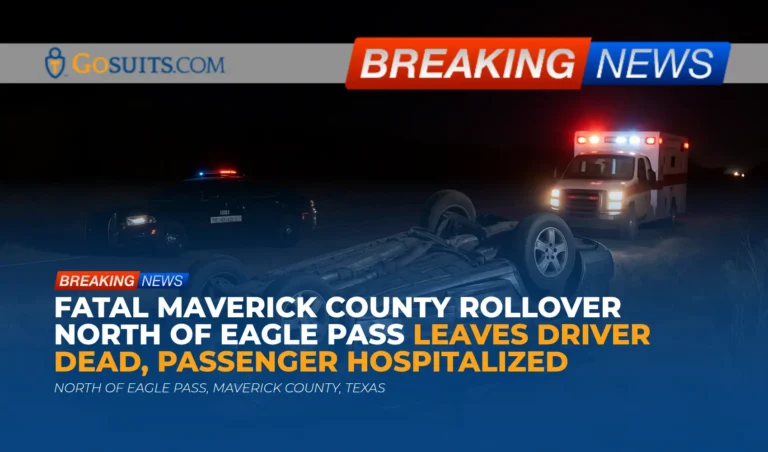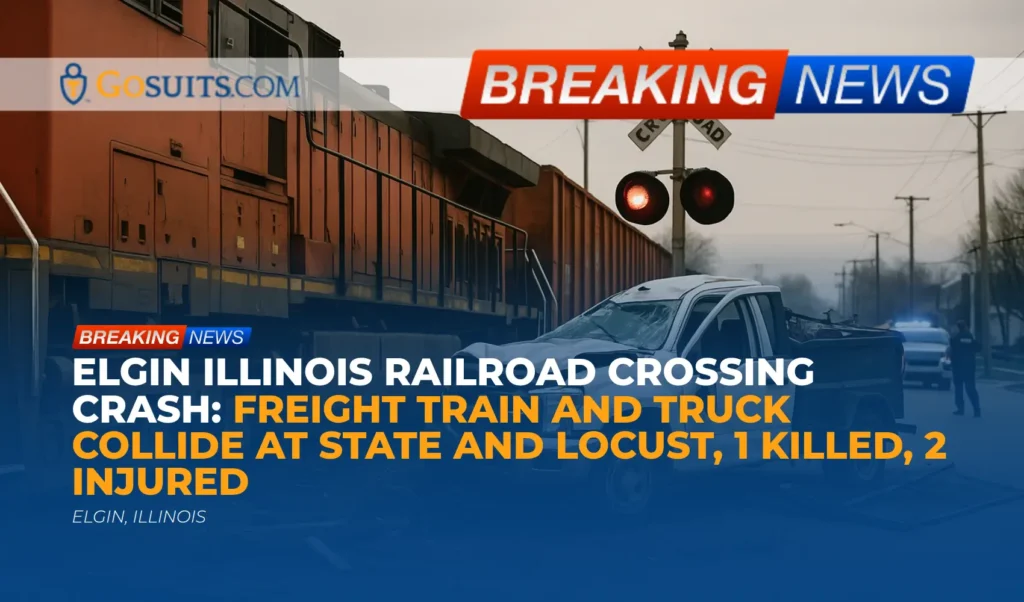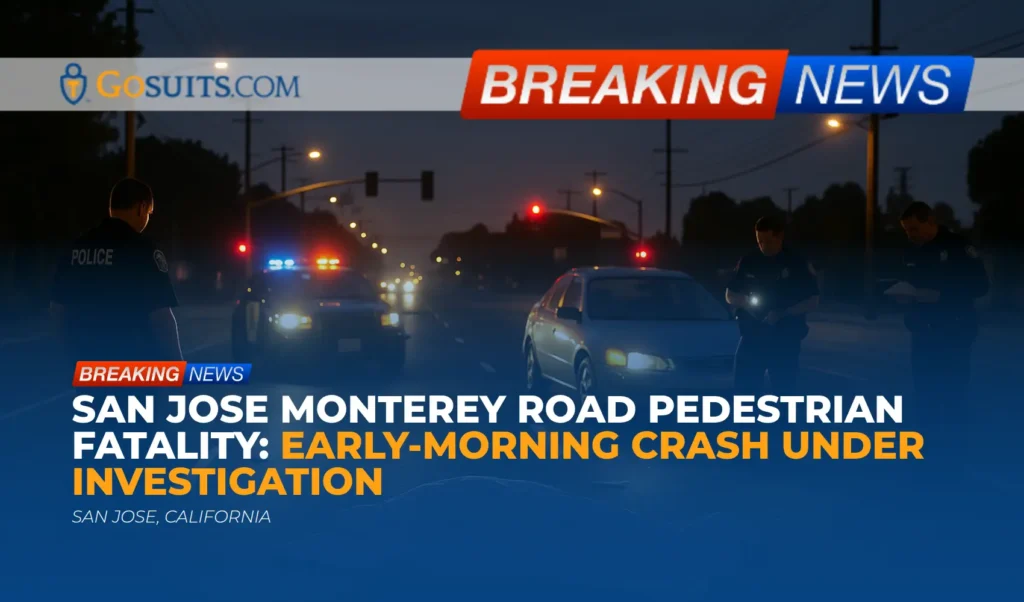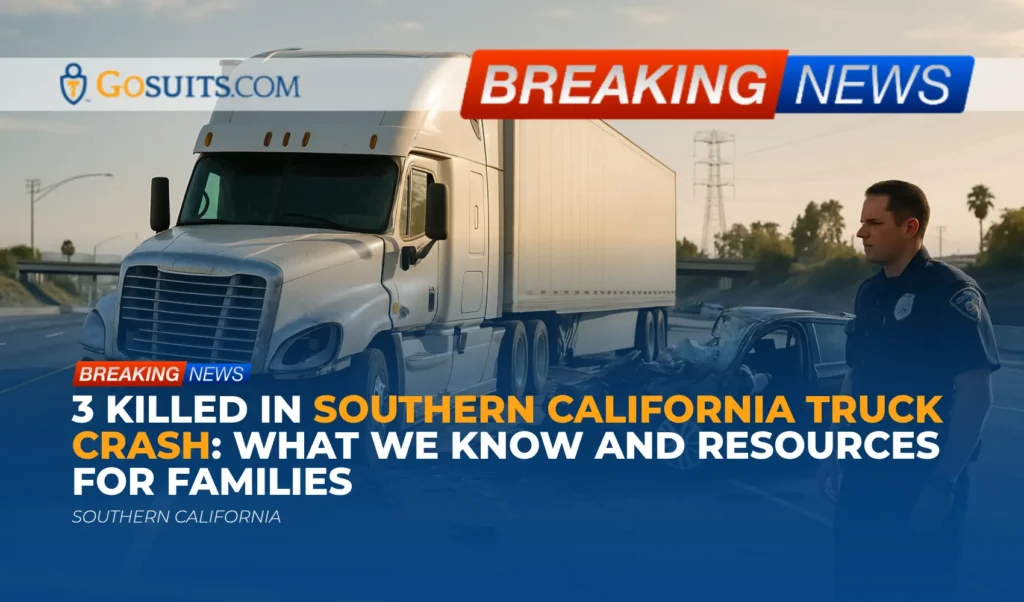- What is known about the rollover north of Eagle Pass
- Location, time, and agencies involved
- Injuries reported and immediate medical response
- How single-vehicle rollovers are investigated
- Legal insight on potential civil liability and victims’ rights
- How to obtain official records and documents
- Insurance issues after a fatal rollover
- Rights of the surviving passenger and the family in Texas
- Safety context: rollover and ejection risks on rural highways
- Helpful contacts and public resources
- Commentary from Gosuits Eagle Pass, Texas Personal Injury Attorney
- Time-sensitive steps that protect families’ options
What is known about the rollover north of Eagle Pass
According to preliminary details from Texas authorities, a single-vehicle crash occurred late Thursday night on a rural state highway north of Eagle Pass in Maverick County. First responders were dispatched at approximately 11:10 p.m. The vehicle involved was a 2007 gray Honda Pilot sport utility vehicle traveling southbound. Investigators reported that the SUV left the roadway into a south bar ditch and then overcorrected back across lanes, overturning several times. During the rollover sequence, the driver, a 38 year old man from Iowa identified by law enforcement, was ejected and pronounced deceased at the scene. A passenger was transported to University Hospital in San Antonio for emergency care. The Texas Department of Public Safety Highway Patrol indicated that investigation is ongoing.
Early media reports referenced both State Highway 151 and State Highway 131 in relation to the site of the crash about 18 miles north of Eagle Pass. Because agency investigations are still active, route designations in public reports may be clarified as more official information is released.
Location, time, and agencies involved
Location: A rural stretch roughly 18 miles north of Eagle Pass in Maverick County, Texas, on or near a state highway corridor described in initial reports.
Time: Approximately 11:10 p.m. on a Thursday. Nighttime, rural environments can bring additional risk factors such as limited visibility and narrow shoulders.
Agencies: The Texas Department of Public Safety Highway Patrol is leading the crash investigation. Local emergency medical services responded and transported the surviving passenger to a regional trauma hospital in San Antonio.
Injuries reported and immediate medical response
The driver was ejected during the rollover and was pronounced deceased at the scene. Ejection in a rollover is strongly associated with severe and often fatal trauma. The passenger was transported to University Hospital in San Antonio, a major trauma facility, for treatment. Specific medical conditions of the passenger have not been publicly disclosed as of this writing.
When serious crashes occur in rural areas, extended response and transport times are common due to distance to higher level trauma centers. Investigators typically document triage decisions, scene times, and transport destinations as part of the crash report and related medical records.
How single-vehicle rollovers are investigated
Even when only one vehicle is involved, a thorough investigation examines multiple potential contributing factors. In a rural rollover with ejection, investigators may evaluate the following:
- Roadway evidence such as tire marks, gouges, debris fields, vehicle rest position, and roadway geometry.
- Vehicle dynamics including speed estimates, steering inputs, braking evidence, stability control or ABS fault codes, and whether the vehicle’s center of gravity and loading could have influenced rollover propensity.
- Occupant protection including seat belt use indicators, airbag deployment, seat track position, and whether any restraint systems show signs of failure or misuse.
- Tire and mechanical condition including tread depth, tire pressures, and any signs of blowout, separation, or suspension faults.
- Environmental conditions such as lighting, weather, road surface condition, and shoulder design and maintenance.
These fact patterns can inform future safety planning and can also become important in civil claims evaluation if a defect, maintenance issue, or another legally significant factor contributed to the crash.
Legal insight on potential civil liability and victims’ rights
Families are often left with questions after a single-vehicle rollover. While every case is unique, investigating the following categories can help clarify civil liability and potential insurance coverage. The overview below is intended for general information and is not a substitute for individualized guidance.
Vehicle product defect considerations and preserving evidence
Complex rollovers sometimes involve safety system performance questions, including whether seat belts latched and locked properly, whether airbags deployed as designed, and whether roof structures maintained survival space. Tire condition and potential tire failures are also examined. If a product-related concern is suspected, it is important to preserve the vehicle in its post-crash condition, including the restraint systems and tires, so qualified experts can inspect them.
Families can ask the towing yard in writing to hold the vehicle without alteration until they receive advice about evidence preservation. In Texas, this step can be time sensitive due to storage fees and potential disposal policies.
Roadway condition and potential government liability
Rural highways can pose hazards linked to shoulder drop-offs, narrow or soft shoulders, sign visibility, or inadequate clear zones. Claims against governmental entities are subject to important limitations and notice requirements under Texas law. While the specifics of those laws are beyond the scope of this article, it is generally significant to document the roadway condition promptly with photographs, measurements, and witness accounts if roadway design or maintenance may have played a role.
Comparative fault and passenger claims
In Texas, passengers injured in a single-vehicle crash commonly pursue claims against available insurance policies, including the driver’s liability coverage and, when applicable, their own uninsured or underinsured motorist coverage. Fault determinations are fact specific and rely on the official report, witness statements, physical evidence, and medical documentation.
When a loved one has died, two civil claim types may be relevant in Texas: wrongful death claims brought by certain surviving family members and a survival action on behalf of the estate for injuries suffered by the decedent before death. See the section below on rights and time limits for a general overview.
How to obtain official records and documents
Public agencies maintain several critical records after a serious crash. Requesting and organizing these documents can help families understand what happened and support insurance claims or potential civil actions.
Crash report from TxDOT
In Texas, the official crash report is the CR-3, prepared by law enforcement and maintained by the Texas Department of Transportation. Eligible parties can purchase the CR-3 online through the Texas Crash Records Information System. Visit the TxDOT crash report portal at cris.dot.state.tx.us/public/Purchase. TxDOT provides general information on crash reports at txdot.gov.
When searching, have the crash date, location, and involved names, if available. Processing times can vary.
Autopsy or inquest records and the coroner authority
Texas uses a combination of medical examiner offices and justices of the peace to conduct inquests depending on the county. In counties without a medical examiner, a justice of the peace typically serves as the coroner authority and may order an autopsy. The Texas Code of Criminal Procedure Chapter 49 outlines inquest and autopsy procedures. You can review these statutes at statutes.capitol.texas.gov/Docs/CR/htm/CR.49.htm.
For Maverick County, families can contact the local justice of the peace office to ask about the inquest, autopsy status, and how to request copies. If an autopsy was performed at a regional medical examiner facility, that office may issue the report. Agencies sometimes require proof of relationship or court authorization before releasing certain records.
Death certificate
Certified death certificates are issued through the Texas Department of State Health Services Vital Statistics. Instructions and eligibility details are available at dshs.texas.gov/vital-statistics/death-records. Funeral homes often assist families with the initial request, but certificates can also be obtained directly from the state or local registrar.

EMS and hospital records
Emergency medical services run sheets and hospital records document injuries, treatments, and outcomes. Release typically requires proper authorization. Hospitals and EMS agencies provide request forms upon proof of authority from the patient or legal representative of the decedent’s estate.
Towing, storage, and vehicle release
Contact the law enforcement agency listed on the crash report to identify the towing company and storage lot location. The Texas Department of Public Safety Highway Patrol can help families determine which wrecker service responded. The DPS website provides Highway Patrol information at dps.texas.gov. Obtain photographs of the vehicle before any repairs or disposal if future evaluation may be needed.
Insurance issues after a fatal rollover
Insurance claims after a single-vehicle rollover often involve multiple coverages. Understanding what may apply can help families prepare for conversations with insurers.
Liability coverage, PIP, MedPay, and UM or UIM
- Liability coverage on the vehicle’s policy may address injury claims from passengers or others harmed by the driver’s alleged negligence.
- Personal Injury Protection or Medical Payments coverage can provide limited no-fault benefits for medical costs and related expenses, depending on policy terms.
- Uninsured or Underinsured Motorist coverage under a passenger’s own policy can apply if liability coverage is insufficient, though circumstances vary.
Insurance companies may request recorded statements, authorizations, and early settlements. What someone says to an insurer can be used to limit or deny claims. It is generally prudent to consult with a qualified attorney before providing statements or signing documents, so rights and options are clearly understood.
Property damage and personal effects
Property recovery from a towed vehicle typically requires proof of authority and coordination with the storage facility. Photographing the vehicle and preserving key components, especially restraint systems and tires, can be important where product performance is in question.
Rights of the surviving passenger and the family in Texas
Texas civil law provides avenues for certain relatives to seek accountability and for an estate to recover for injuries the decedent suffered before death. These are general frameworks and may not fit every circumstance.
Wrongful death and survival actions
Wrongful death actions in Texas may be brought by specific family members for their own losses stemming from a loved one’s death. A separate survival action is typically brought by the decedent’s estate, seeking damages the decedent could have claimed had they survived. Courts consider evidence such as the crash report, witness testimony, medical records, and forensic evaluations of vehicles and roadway conditions.
Texas law imposes deadlines to bring civil claims. Many wrongful death and personal injury actions have a two year limitations period. See Texas Civil Practice and Remedies Code section 16.003, available at statutes.capitol.texas.gov/Docs/CP/htm/CP.16.htm#16.003. There can be exceptions or separate notice requirements in certain cases, especially those involving governmental entities, so reviewing timelines early helps avoid losing the ability to file.
Passengers injured in a single-vehicle crash may have claims under liability or uninsured motorist policies even when they are related to the driver, though specific policy terms and exclusions vary.
Safety context: rollover and ejection risks on rural highways
Rollover crashes are less common than other crash types but are disproportionately deadly. Ejection risk is a key factor in fatality. National highway safety data underscore several points that are useful for community awareness:
- Seat belts are the most effective measure to prevent fatal injuries and ejection. NHTSA notes that seat belt use significantly reduces risk of death and that people not wearing seat belts are far more likely to be ejected in a crash. See nhtsa.gov/risky-driving/seat-belts.
- Rollover dynamics. NHTSA explains that factors like vehicle type, speed, tripping on soft shoulders, and overcorrection can contribute to rollovers. More information is available at nhtsa.gov/vehicle-safety/rollover.
- Nighttime and rural risk. National data consistently show higher fatality rates on rural roads, where emergency response times are longer and shoulders may be narrow or unpaved. The Centers for Disease Control and Prevention provides occupant protection and road safety resources at cdc.gov/transportationsafety/seatbelts.
Overcorrection is frequently mentioned in rural lane departure crashes. If a vehicle leaves the roadway into a bar ditch or soft shoulder, abrupt steering inputs to reenter the lane can induce loss of control and rollover. While investigators have not released detailed causation analyses regarding this crash, the mechanism described is consistent with known rollover dynamics.
Helpful contacts and public resources
Public agencies and state resources can assist with records and information. The following links and descriptions are provided for general guidance.
- Texas Department of Public Safety Highway Patrol – Statewide Highway Patrol contact information and public safety resources are at dps.texas.gov. Families can ask which DPS office handled the report and how to coordinate retrieval of towing information.
- TxDOT Crash Records Information System – Purchase eligible CR-3 crash reports online at cris.dot.state.tx.us/public/Purchase. General TxDOT information is at txdot.gov.
- Autopsy and inquest statutes – Texas Code of Criminal Procedure Chapter 49 outlines the roles of medical examiners and justices of the peace in investigating deaths and ordering autopsies. Text at statutes.capitol.texas.gov/Docs/CR/htm/CR.49.htm.
- Death certificates – Texas Department of State Health Services Vital Statistics, including eligibility, forms, and ordering options at dshs.texas.gov/vital-statistics/death-records.
- General occupant protection and rollover information – NHTSA seat belt and rollover safety pages at nhtsa.gov/risky-driving/seat-belts and nhtsa.gov/vehicle-safety/rollover.

Commentary from Gosuits Eagle Pass, Texas Personal Injury Attorney
Our hearts are with everyone affected by this rollover north of Eagle Pass. Any loss of life on our roads reverberates through families and the community. The information provided here is for general education to help people understand the process after a serious crash.
Based on the facts reported so far, investigators noted a departure into a bar ditch and an overcorrection that led to multiple rollovers and an ejection. Rollover sequences are violent, and ejection is a strong indicator of catastrophic forces. In similar cases, careful review of seat belt function, airbag deployment, tire condition, and roadway edge conditions is important. The goal is not to assign blame prematurely but to make sure all contributing factors are considered and documented.
Insurance companies and large corporations involved in vehicles, components, or roadway maintenance often move quickly after serious incidents. Adjusters may seek statements, medical authorizations, or quick settlements before the full story is known. These early steps can shape a claim and may leave out critical evidence like restraint system inspections or roadway measurements. That is why many people choose to talk with a seasoned attorney first, to understand their rights and avoid inadvertently limiting their options.
Free consultations allow people to ask questions without pressure and to understand timelines, records to request, and how insurance interactions might affect their claims. Even if no claim is ultimately pursued, early guidance can help families make informed decisions in a very difficult moment.
Time-sensitive steps that protect families’ options
This section is meant to help community members understand why acting promptly after a serious crash can matter. It outlines practical steps that often preserve information and choices for later.
- Secure the official crash report. The CR-3 contains key findings, diagrams, and officer notations. Obtaining it early helps align medical and insurance documentation and can guide next steps.
- Preserve the vehicle and components. If a rollover or ejection occurred, the condition of seat belts, airbags, seats, and tires can be decisive. Request in writing that the storage yard hold the vehicle and not release or destroy it until an inspection is arranged.
- Collect photographs and scene information. Photos of the roadway, shoulder drop-offs, signage, and lighting within days of the incident can be far more accurate than months later. Weather and maintenance conditions change.
- Organize medical and EMS records. Promptly requesting EMS run sheets and hospital discharge summaries or admission records helps establish the injury timeline and supports insurance submissions.
- Document financial impacts. Keep records of funeral costs, travel expenses, missed work, and communications with insurers. A contemporaneous file avoids later gaps.
- Be careful with recorded statements. Insurance adjusters may call quickly. People in these situations often choose to consult an attorney before giving any recorded statement, because what is said can affect coverage and fault assessments.
- Track deadlines. Civil claims generally have filing deadlines. In Texas, many injury and wrongful death claims have a two year statute of limitations, and some claims against government entities have additional notice requirements that can be much shorter. Calendar these periods early.
- Consider a no cost legal consultation. Speaking with a lawyer before engaging with insurance companies can clarify coverage, identify missing records, and help avoid missteps. A consultation can also flag whether specialized inspections are needed to preserve critical evidence.
Acting on these steps early does not commit anyone to a particular course of action. It simply keeps options open while facts are gathered and the community supports those most affected.
Additional safety notes and references
Because ejection was reported in this crash, it is worth underscoring that modern restraint systems are designed to keep occupants inside the protective space of the vehicle. National safety agencies emphasize:
- Seat belt effectiveness in preventing ejection and reducing fatal injuries. See NHTSA’s overview at nhtsa.gov/risky-driving/seat-belts.
- Rollover risk factors, including tripping mechanisms and overcorrection on rural shoulders. See nhtsa.gov/vehicle-safety/rollover.
- General occupant protection resources from the CDC at cdc.gov/transportationsafety/seatbelts.
These resources are educational and can help communities advocate for safer driving practices and roadway improvements where needed.






